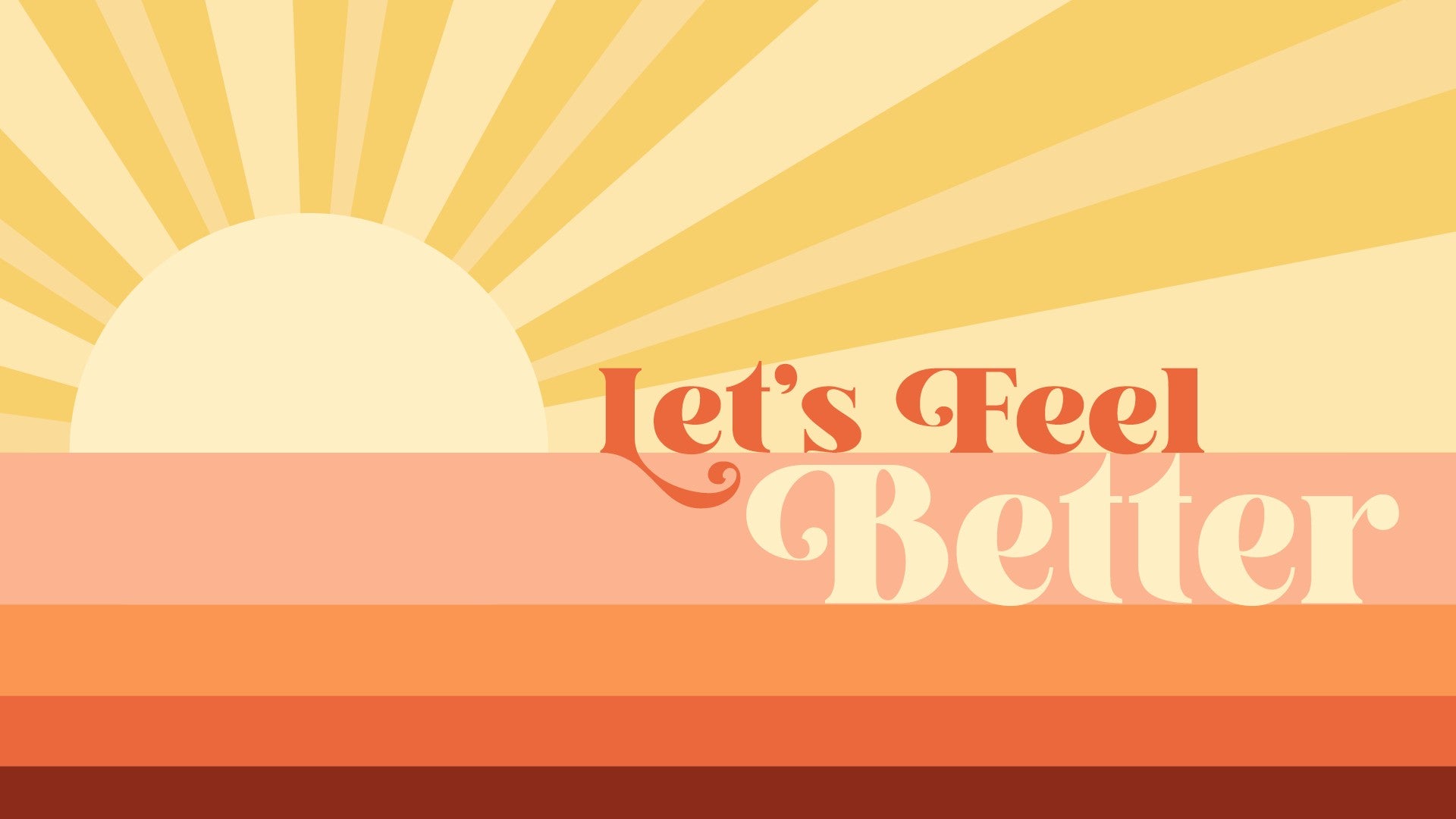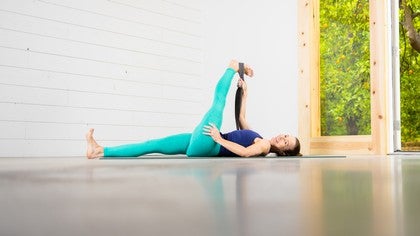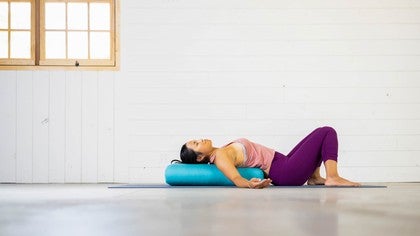Description
About This Video
Transcript
Read Full Transcript
Thank you for joining me. So this is the short practice that I do to feel better many times at the end of the day when I'm tired. So I use two blankets, roll them up, one by my left hip, one by my right hip, and then I use a strap. So I start by lying down. Definitely my go-to practice. And then using my strap, I wrap it around my right foot, extend my right leg up, and just at the end of the day when I do this practice, it's just a moment for me to pause and stop and tune into my breath, my body, making it very simple. And then I take the straps into my right hand, and I bring my right leg out to the side, and that rolled-up blanket on my right side is supporting my right leg, which makes this more restorative. So it's definitely kind of a restorative practice, like a deep stretch. Doesn't take a lot of effort, so it's just really easy for me to convince myself to go to my mat. Sometimes, you know, if you know it's a strong practice, you can walk in circles around your mat until you finally make up your mind to do it. And then I bring the right leg up, and I take the leg across to get into the lateral hamstring and outer hip, and I'm not lifting the back of my pelvis, but keeping the back of my pelvis down, and I turn my right leg out a little bit, and it feels really good. Can also be really intense, but I'm feeling my way into each stretch, and then coming back to center, and then I just simply switch sides. It's definitely not a very ambitious practice, which is nice because there's so many times with what we do in life that we become overly ambitious. It's a very receptive practice. So first the hamstring stretch, and then I take the leg out to the side for the inner thigh stretch, and again that rolled-up blanket is giving me nice support. You can always use a block or pillows. Something soft though I actually prefer. Something stable as well. And then I bring the leg back up, and I take the leg across. Sometimes I hook my left thumb into my left hip crease, driving that outer left hip forward, turning my left leg out as I take the leg across, and flexing the foot will definitely make a difference as to where you feel the stretch. My left side is typically a little bit tighter, so I stay here longer. So really tuning into what I need at any given moment as I'm practicing. And then bringing the leg back to center, and then I take the strap off. And definitely my favorite to go to hip stretch is thread the needle, so right outer ankle on top of the left thigh, and then I hold around my left shin or the back of my left thigh. And for most people this is also really safe on the knee if you have any issues with knee. Also really good if you have tight hips. And then I stay here typically for about a minute, and I remind myself to relax and soften my shoulders, soften my throat, soften my jaw, and use my exhalation to relax into the stretch. And then after about a minute or so, switching sides. And sometimes I put on some calming music, or just simply listening to the sound of my breath or sounds coming from the outside, using the exhalation to soften, to relax into the stretch. And my left side is a little tighter, so I tend to stay here a little bit longer. So really listening to the feedback that I get from my body. Really tuning in, and then stretching both legs up in the air, and then hands to the inner knees or inner thighs, and a wide straddle. And a lot of people need to bend their knees absolutely fine, as long as you feel a nice release to the inner thighs. And bringing the legs back together, and then coming into Supta Baddha Konasana. And the blankets are right there, so I don't have to do a whole lot. Just soles of the feet together, and then my legs are nicely supported. And then I grab my elbows, extend the arms behind my head. And this just feels really good on the whole torso, and a nice release to the inner thighs, inner groin area. You may have to build the support up to meet your legs. And then when you're here, it's nice to focus on breathing down into your belly. So allow your belly to rise as you're breathing in, and allow your belly to fall back down as you're breathing out. So the yoga practice is really about bringing my attention inside, finding that moment in the day where I can feel very calm and connected, kind of letting go of the day, processing also the day in a way. So you can stay in this pose much longer if you like, but if you're ready to transition to the next pose, manually bring your knees together, and then bring your knees into your chest. And then I like to cross my ankles, separate my knees a bit apart, and then gently hugging your knees into your chest. Nice release for your lower back. And then stretch your legs out onto the floor, interlace your fingers, and press the palms of your hands up towards the ceiling, extend your arms behind you. And here, taking some deeper, fuller, more satisfying breaths, sometimes stretching a little bit more through the right leg and the right hand and the left leg and the left hand. A big part of yoga for me is creating more space in the body, and it feels that times when I'm able to do that it feels like my mind has more space. And then bring your arms up, bend your knees, and then move your hips a little bit to your right, and straighten your left leg out, and extend the right arm out to the side, and then exhale taking it into a twist. And this is where the blanket can give that right knee some support. You may have to build it up or use a bolster instead, and then you can either look up or turn your gaze to your right, and sometimes exploring, reaching your right arm behind your head, kind of reaching the fingertips towards the wall behind you, feeling that whole right side of your body breathing in and breathing out. So you're just kind of unwinding, and then coming back to center. And you may need to hug your knees into your chest just briefly for your lower back, and then shifting your hips to your left and straighten your right leg out, and then exhale left knee to the right, and maybe you still have that blanket there, a bolster, and then extending your left arm out to the side. So you can look up or you can look over to your left. So again unwinding, you can reach your left fingertips towards the wall behind you, feeling that the left side of your body is breathing in and breathing out. So it's a kind of restorative, luxurious, receptive practice. And then coming back to center, hugging your knees into your chest. And then typically what I'll do, I will either take a blanket, and it's right there for me underneath the knees, and then I will take another blanket or a bolster or pillows and place it either across my thighs or my belly or both thighs and belly. And sometimes I'll have three, four blankets or two big pillows. That kind of weighing my body down is very calming and nourishing, great for you know, if you have, if you feel restless or feel anxious, putting that weight on you will be really helpful. So typically my Shavasana will be anywhere between five and fifteen minutes, and for me this is a way to meditate, a way to kind of sink, to pause, to keep me sane, you know, because we all have a lot going on and it's so easy to be pulled in so many different directions. So my practice is really about turning my attention inside, pausing, and then finding kind of an inner gaze, my mind's eye first resting in the center of my chest.
Imagine that you're breathing in and out through the center of your chest as if your chest is doing all the breathing. And when you take your attention to a place like your chest, it's also a way to calm your mind, to get out of all the thinking, all the planning, and with each exhalation, relaxing your shoulders, your arms, your upper back. And you'll find that if you're able to rest one part of your body, the rest of your body kind of follows. Allow your eyes to be still with more of a downward inner gaze. Allow your face to softly smile, your eyes to softly smile. And of course you can stay here much longer. If you start to bring yourself back, do it slowly, right? So if you can just do it slowly and then that can kind of transition into the rest of your day. And then in general, when you find that calm place, it's contagious. People will, people will feel it. You're spreading the calm. You're spreading the yoga. Thank you for joining me. Namaste.
Let's Feel Better
Comments
You need to be a subscriber to post a comment.
Please Log In or Create an Account to start your free trial.

















